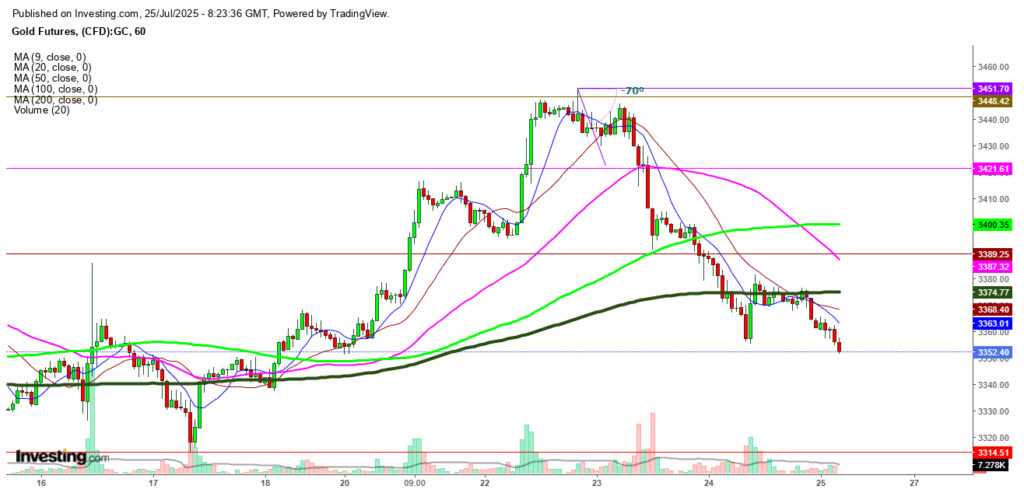The intricacies of the financial market, particularly those related to commodities like gold, can both intrigue and perplex investors and market observers. The fluctuations in the gold futures market during a specific period in July provide a quintessential example of how geopolitical and economic sentiments can interplay, affecting asset prices. This narrative will dissect these movements, providing a backdrop for understanding for those less familiar with the ongoing developments.
In the span of five trading sessions beginning on July 17, we observed a notable fluctuation in gold futures. Initially, the price plunged to a low of $3314, an occurrence that might have raised eyebrows among market spectators. However, the resilience of gold was soon evident as it rebounded to a recent peak of $3451 on July 22. Such a swift recovery is not uncommon in the commodities market, where sentiment can shift rapidly. Yet, this resurgence was short-lived. An onset of a selling spree ensued, effectively wiping the gains and precipitating a fall below the 200-day moving average (DMA) within merely two trading sessions. This drop unfolded against the backdrop of increasing optimism surrounding tariff trade deals.
Gold traditionally serves as a haven asset, a sanctuary for investors during times of uncertainty and market volatility. Despite this price setback, gold retained some of its haven appeal. Market participants braced themselves in anticipation of a series of pivotal events on the horizon. Primary among these was the stance of the Federal Reserve (Fed) on interest rates, a subject of keen interest given the repeated urgings from the US President, Donald Trump, for rate cuts. In this climate of heightened anticipation, the position of Jerome Powell, Chair of the Federal Reserve, was markedly significant. He suggested that the uncertainty surrounding the inflationary implications of Trump’s tariffs was a compelling reason for the Fed to refrain from any immediate adjustments to interest rates.
Compounding the intrigue was Trump’s looming August 1 deadline for imposing steep trade tariffs, a policy move with far-reaching implications. Market participants were on tenterhooks, eager to see whether this deadline would usher in more trade agreements.
Delving into the technical aspects of the market movements, the pressure on gold futures was palpable. By the end of the trading week, prices were observed to be under the crucial benchmark of the 200 DMA, positioned at $3374. This positioning was evident in the 1-hour chart, which highlighted a series of bearish indicators. Notably, there were observable bearish crossovers where the 50 DMA dipped below the 100 DMA, coupled with the 9 DMA and 20 DMA descending below the 200 DMA. Such formations signal potential for further declines.
A glance at the daily chart reinforced this bearish sentiment. Here, gold futures exhibited three Outside Bearish patterns, hinting at the potential for a sharp downturn. The weekly chart echoed this, showcasing a bearish hammer formation, suggesting the possibility of a confirmatory bearish trend in the following sessions. Should the weekly candle close below $3313 before the week’s end, it could signify sustained price exhaustion in the weeks ahead, especially if tariff trade negotiations continue to make headway.
In synthesizing these observations, it’s crucial to underline that this analysis, while grounded in technical assessment, is predicated on observed market patterns without predictive assurance. The volatile nature of gold futures, compounded by the kaleidoscopic interplay of geopolitical and economic developments, underscores the necessity for investors to approach with caution and informed judgement.
In conclusion, the narrative of gold futures in this turbulent period offers a compelling case study on the unpredictability of financial markets. Amidst a tangle of economic policies, geopolitical tensions, and investor sentiment, gold continues to assert its role, both as a haven asset and a barometer of wider market health. As we proceed, the unfolding dynamics of tariff negotiations and global economic policies will undoubtedly continue to shape the trajectories of commodities like gold, underscoring the perennial need for vigilance and adaptability in investment strategies.


